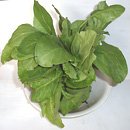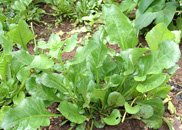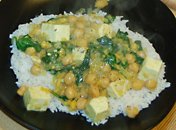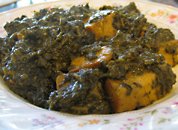Spinach Nutrition facts
Spinach (Spinacia oleracea) is a remarkable green leafy vegetable often esteemed as a functional food for its health-enhancing antioxidants and anti-cancer compounds. Its tender, crispy, dark green leaves are cherished ingredients in kitchens worldwide.
Botanically, it belongs to the Amaranthaceae family, bearing the scientific name Spinacia oleracea.
The Spinacia plant reaches a height of about 1 foot. While it can be cultivated year-round, the freshest greens are typically available shortly after the winter season, from March through May in the Northern Hemisphere and from September until November in the Southern Hemisphere.

|

|
| Spinach (Spinacia oleracea). | Spinach plant- broad green leaves. |
At least two varieties of spinach are cultivated for their edible leaves: the Savoy type, characterized by dark-green crinkle (wrinkled) leaves, and the flat-leaf variety, distinguished by its smooth-surfaced leaves.
Health Benefits of Spinach
<Spinach is a treasure trove of many phytonutrients with health promotion and disease prevention properties.
It boasts low calorie and fat content (just 23 calories per 100g of raw leaves) while also being rich in soluble dietary fiber. It's no wonder these leafy greens are often recommended by dieticians for cholesterol control and weight reduction programs!
A fresh 100g serving of spinach contains approximately 25% of the daily recommended intake of iron, one of the highest among green leafy vegetables. Iron is essential for red blood cell production and acts as a co-factor for the oxidation-reduction enzyme cytochrome oxidase during cellular metabolism.
Fresh spinach leaves are abundant in vital antioxidant vitamins such as vitamin A, vitamin C, and flavonoid polyphenolic antioxidants like lutein, zeaxanthin, and β-carotene. These compounds collectively function as protective scavengers against oxygen-derived free radicals and reactive oxygen species (ROS), contributing to the prevention of aging and various diseases.
Zeaxanthin, a significant dietary carotenoid, is absorbed selectively into the retinal macula lutea in the eyes, providing antioxidant and protective UV light-filtering functions. This helps protect against "age-related macular disease" (ARMD), particularly in older adults.
Vitamin A, essential for maintaining healthy mucosa and skin, is crucial for night vision. Consumption of natural vegetables and fruits rich in vitamin A and flavonoids is also known to provide protection against lung and oral cavity cancers.
Spinach leaves are an exceptional source of vitamin K, providing 402% of the daily requirements in a 100g serving. Vitamin K plays a vital role in strengthening bone mass by promoting osteoblastic activity and has established benefits in patients with Alzheimer's disease by limiting neuronal damage.
This green leafy vegetable also contains significant amounts of various B-complex vitamins such as vitamin B6 (pyridoxine), thiamin (vitamin B-1), riboflavin, folates, and niacin. Folates are particularly crucial in preventing neural tube defects in newborns.
A 100g serving of fresh spinach provides 47% of the daily recommended levels of vitamin C. Vitamin C is a potent antioxidant, aiding in resistance against infectious agents and scavenging harmful oxygen-free radicals.
Spinach leaves are also rich in minerals such as potassium, manganese, magnesium, copper, and zinc. Potassium regulates heart rate and blood pressure, while manganese and copper act as co-factors for the antioxidant enzyme superoxide dismutase. Copper is also essential for red blood cell production, and zinc acts as a co-factor for numerous enzymes regulating growth, development, digestion, and nucleic acid synthesis.
Additionally, spinach serves as a modest source of omega-3 fatty acids.
Incorporating spinach into your regular diet aids in preventing osteoporosis (bone weakness) and iron-deficiency anemia.
Furthermore, its tender leaves are thought to offer protection against cardiovascular diseases as well as cancers of the colon and prostate.
Discover more about spinach nutrition per 100g through our informative infographic. Visit this page.
| Principle | Nutrient Value | Percent of RDA |
|---|---|---|
| Energy | 23 Kcal | 1% |
| Carbohydrates | 3.63 g | 3% |
| Protein | 2.86 g | 5% |
| Total Fat | 0.39 g | 1.5% |
| Cholesterol | 0 mg | 0% |
| Dietary Fiber | 2.2 g | 6% |
| Vitamins | ||
| Folates | 194 µg | 48.5% |
| Niacin | 0.724 mg | 4.5% |
| Pantothenic acid | 0.065 mg | 1% |
| Pyridoxine | 0.195 mg | 15% |
| Riboflavin | 0.189 mg | 14.5% |
| Thiamin | 0.078 mg | 6.5% |
| Vitamin A | 9377 IU | 312% |
| Vitamin C | 28.1 mg | 47% |
| Vitamin E | 2.03 mg | 13.5% |
| Vitamin K | 482.9 µg | 402% |
| Electrolytes | ||
| Sodium | 79 mg | 5% |
| Potassium | 558 mg | 12% |
| Minerals | ||
| Calcium | 99 mg | 10% |
| Copper | 0.130 mg | 14% |
| Iron | 2.71 mg | 34% |
| Magnesium | 79 mg | 20% |
| Manganese | 0.897 mg | 39% |
| Zinc | 0.53 mg | 5% |
| Phyto-nutrients | ||
| Carotene-ß | 5,626 µg | -- |
| Crypto-xanthin-ß | 0 µg | -- |
| Lutein-zeaxanthin | 12,198 µg | -- |
Selection and Storage
Spinach is at its peak during the winter season. When selecting spinach at the market, opt for fresh leaves that exhibit a deep green color, vibrancy, and crisp texture. Avoid those with dull or sunken leaves, yellowing, or spots.
Upon bringing spinach home, thoroughly wash the leaves under clean running water and rinse them in saltwater for approximately 30 minutes to eliminate any dirt or residues from insecticides.
Although spinach can be stored in the refrigerator for up to a week, it's best to consume fresh leaves as soon as possible to maximize their nutritional benefits.
Preparation and serving methods
Prior to using the leaves in cooking, rinse them under cold water. Gently dry them by patting with a tissue or soft cloth. Remove any tough stems by trimming. Raw leaves can be chopped or utilized whole in a multitude of recipes.

|
| Spinach-rice with chickpeas and tofu. Photo courtesy: scottfeldstein |

|
| Palak-paneer. Thoroughly cooked spinach leaves mashed, sauteed and mixed with paneer) cubes. |
Here are some serving tips:
Fresh, tender spinach leaves (baby spinach) can be enjoyed raw in salads, vegetable burgers, or as juice. However, it's worth noting that their antioxidant properties may decrease significantly when subjected to steaming, frying, or prolonged boiling.
Spinach leaves are commonly incorporated alongside other vegetables or mushrooms in dishes such as noodles, pies, pasta, pilaf (pulao), and soups. They are also used in the preparation of baby foods.
You can create Mediterranean-style dishes like spinach soufflé, casseroles, lasagna, quiche, and spinach-filled tortellini using spinach.
In India and Pakistan, where spinach is known as "palak," it features in various delicious dishes such as "palak paneer" (a dish made with Indian cottage cheese), aloo-palak (with potatoes), fried rice, chicken, and meat preparations.
In India and Bangladesh, spinach is often combined with other seasonal greens like goosefoot (Chenopodium album), fenugreek, mustard greens, and Malabar spinach (Basella alba) to create "saag," which is typically served with unleavened bread (roti) or rice.
Safety profile
Reheating leftover spinach can lead to the conversion of nitrates into harmful nitrites and nitrosamines by certain bacteria. These compounds, prevalent in pre-prepared nitrate-rich foods like spinach and various green vegetables, may pose health risks, particularly for children.
The presence of phytates and dietary fiber in spinach leaves could hinder the absorption of essential minerals such as iron, calcium, and magnesium.
Spinach, rich in vitamin K, is advised to be avoided by individuals taking anti-coagulants like "warfarin" due to its potential interference with drug metabolism.
Oxalic acid, a naturally occurring substance in certain vegetables like spinach, may crystallize as oxalate stones in the urinary tract for some people. Those with known oxalate urinary tract stones are recommended to steer clear of vegetables from the Amaranthaceae and Brassica family, ensuring adequate water intake to maintain normal urine output.
Spinach might also contain goitrogens, which can disrupt thyroid hormone production, potentially causing thyroxin hormone deficiency in individuals with thyroid dysfunction
Also read ≻≻-
≻≻- Arugula (Salad rocket) Nutrition facts.
≻≻- Lamb's lettuce (Mâche) Nutrition facts.
≺≺ Back to Vegetables from Spinach nutrition. Visit here for an impressive list of vegetables with complete illustrations of their nutrition facts and health benefits.
≺≺ Back to Home page.
Further reading:
Refer Vegetable information page - University of Illinois Extension. (Link opens in new window).
USDA National Nutrient Database.(Link opens new window)
Vegetables Oxalate- Oxalosis and Hyperoxaluria Foundation.